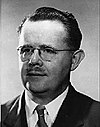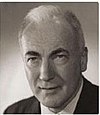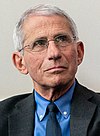National Institute of Allergy and Infectious Diseases
 | |
| Institute overview | |
|---|---|
| Formed | December 29, 1955 |
| Preceding Institute |
|
| Jurisdiction | United States Government |
| Headquarters | North Bethesda, Maryland, US (Rockville, Maryland, mailing address) |
| Institute executive |
|
| Parent department | Health and Human Services |
| Parent Institute | National Institutes of Health |
| Website | niaid.nih.gov |
The National Institute of Allergy and Infectious Diseases (NIAID, /ˈnaɪ.æd/) is one of the 27 institutes and centers that make up the National Institutes of Health (NIH), an agency of the United States Department of Health and Human Services (HHS). NIAID's mission is to conduct basic and applied research to better understand, treat, and prevent infectious, immunologic, and allergic diseases.[1]
NIAID has on-campus laboratories in Maryland and Hamilton, Montana, and funds research conducted by scientists at institutions in the United States and throughout the world. NIAID also works closely with partners in academia, industry, government, and non-governmental organizations in multifaceted and multidisciplinary efforts to address emerging health challenges such as the H1N1/09 pandemic and the COVID-19 pandemic.
History
[edit]
NIAID traces its origins to a small laboratory established in 1887 at the Marine Hospital on Staten Island, New York[2] (now the Bayley Seton Hospital).[3] Officials of the Marine Hospital Service in New York decided to open a research laboratory to study the link between microscopic organisms and infectious diseases. Joseph J. Kinyoun, a medical officer with the Marine Hospital Service, was selected to create this laboratory, which he called a "laboratory of hygiene."[4]
Kinyoun's lab was renamed the Hygienic Laboratory in 1891 and moved to Washington, D.C., where Congress authorized it to investigate "infectious and contagious diseases and matters pertaining to the public health."[5][page needed] With the passage of the Ransdell Act in 1930, the Hygienic Laboratory became the National Institute of Health. In 1937, the Rocky Mountain Laboratory, then part of the United States Public Health Service, was transferred to Division of Infectious Diseases, part of the NIH.[citation needed]
In mid-1948, the National Institute of Health became the National Institutes of Health (NIH) with the creation of four new institutes.[6] On October 8, 1948, the Rocky Mountain Laboratory and the Biologics Control Laboratory were joined with the NIH Division of Infectious Diseases and Division of Tropical Diseases to form the National Microbiological Institute. In 1955, Congress changed the name of the National Microbiological Institute to the National Institute of Allergy and Infectious Diseases to reflect the inclusion of allergy and immunology research. That change became effective on December 29, 1955.[7]
List of directors
[edit]The following have been directors of the National Institute of Allergy and Infectious Diseases:[8]
| No. | Portrait | Director | Took office | Left office |
|---|---|---|---|---|
| 1 | 
|
Victor H. Haas | November 1, 1948 | April 1957 |
| 2 | 
|
Justin M. Andrews | April 1957 | October 1, 1964 |
| 3 | 
|
Dorland J. Davis | October 1, 1964 | August 1975 |
| 4 | 
|
Richard M. Krause | August 1975 | July 1984 |
| 5 | 
|
Anthony Fauci | November 2, 1984 | December 31, 2022 |
| – | 
|
Hugh Auchincloss | January 1, 2023 | September 24, 2023 |
| 6 | 
|
Jeanne Marrazzo | September 24, 2023 | Incumbent |
Organizational structure
[edit]
NIAID is composed of the Office of the Director (OD), four extramural divisions:[citation needed]
- Division of Acquired Immunodeficiency Syndrome (DAIDS)
- Division of Allergy, Immunology, and Transplantation (DAIT)
- Division of Microbiology and Infectious Diseases (DMID)
- Division of Extramural Activities (DEA)
and three intramural divisions:[citation needed]
- Division of Clinical Research (DCR)
- Division of Intramural Research (DIR)
- Vaccine Research Center (VRC)[9]
The Dale and Betty Bumpers Vaccine Research Center[10] is composed of four laboratories and two programs:
- Immunology Laboratory
- Viral Pathogenesis Laboratory
- Virology Laboratory
- Vaccine Production Program Laboratory
- Clinical Trials Program
- Translational Research Program[11]
Research priorities
[edit]
NIAID's research priorities are focused on:[citation needed]
- "expanding the breadth and depth of knowledge in all areas of infectious, immunologic, and allergic diseases"
- "developing flexible domestic and international research capacities to respond appropriately to emerging and re-emerging disease threats wherever they may occur."[1]: 8
NIAID's mission areas are:[citation needed]
- Human Immunodeficiency Virus/Acquired Immunodeficiency Syndrome (HIV/AIDS)
- The goals in this area are finding a cure for HIV-infected individuals; developing preventive strategies, including vaccines and treatment as prevention; developing therapeutic strategies for preventing and treating co-infections such as TB and hepatitis C in HIV-infected individuals; and addressing the long-term consequences of HIV treatment.
- Biodefense and Emerging Infectious Diseases (BioD)
- The goals of this mission area are to better understand how these deliberately emerging (i.e., intentionally caused) and naturally emerging infectious agents cause disease and how the immune system responds to them.
- Infectious and Immunologic Diseases (IID)
- The goal of this mission area is to understand how aberrant responses of the immune system play a critical role in the development of immune-related disorders such as asthma, allergies, autoimmune diseases, and transplant rejection. This research helps improve the understanding of how the immune system functions when it is healthy or unhealthy and provides the basis for development of new diagnostic tools and interventions for immune-related diseases.
Achievements
[edit]This section needs additional citations for verification. (November 2016) |
NIAID has established a reputation for being on the cutting edge of scientific progress both through its intramural labs and through the research it funds at academic institutions.[12] For example, NIAID collaborations with various partners led to the development of FDA-approved vaccines for influenza (FluMist), hepatitis A (Havrix), and rotavirus (RotaShield). NIAID also was instrumental in the development and licensure of acellular pertussis vaccines, conjugate vaccines for Streptococcus pneumoniae and Haemophilus influenzae type b or Hib, and a preventive therapy for respiratory syncytial virus or RSV (Synagis). Additionally, NIAID partnerships with industry and academia have led to the advancement of diagnostic tests for several important infectious diseases, including malaria (ParaSight F), tuberculosis (GeneXpert MTB/RIF), and norovirus (Ridascreen Norovirus 3rd Generation EIA).
NIAID has done research on mother-to-child transmission (MTCT) of HIV. In 1994, a study co-sponsored by NIAID demonstrated that the drug AZT, given to HIV-infected women who had little or no prior antiretroviral therapy (ART), reduced the risk of MTCT by two-thirds.[13]
In 1999, an NIAID-funded study in Uganda found that two oral doses of the inexpensive drug nevirapine—one given to HIV-infected mothers at the onset of labor and another to their infants soon after birth—reduced MTCT by half when compared with a similar course of AZT. Subsequent clinical trials, including some funded by NIAID, showed that AIDS drugs also can reduce the risk of MTCT through breast milk. These and other studies have led to World Health Organization recommendations that can help prevent MTCT while allowing women in resource-limited settings to breastfeed their infants safely.
More recently,[when?] NIAID-funded scientists found that testing at-risk infants for HIV and then giving ART immediately to those who test positive dramatically reduces rates of illness and death. HIV-infected infants were four times less likely to die if given ART immediately after they were diagnosed with HIV, when compared with the standard of care (beginning ART in infants when they showed signs of HIV illness or a weakened immune system).
This finding helped influence the World Health Organization (WHO) to change its guidelines for treating HIV-infected infants. The guidelines now strongly recommend starting ART in all children under age 2 immediately after they have been diagnosed with HIV, regardless of their health status.[14][15]

In 2020, the NIAID Office of Communications & Government Relations' News & Science Writing Branch published an HIV Language Guide, "designed to help NIAID staff communicate with empowering rather than stigmatizing language" and it was quickly recognized that it has value beyond NIAID.[16] A draft of the 2024 update was widely circulated, to incorporate feedback from community groups[16] and was published in April 2024[16] using person-first language,[17] but was removed from the NIAID website shortly after the second inauguration of Donald Trump in January 2025,[18] with some commentators suggesting this is as a result of language in the guide around transgender and gender nonconforming people being in contravention of President Trump's executive order "Defending Women from Gender Ideology Extremism and Restoring Biological Truth to the Federal Government".[19][20]
In 2023, NIAID Office of Data Science and Emerging Technologies (ODSET) created the NIAID Data Discovery Portal to enhance the reuse of data and enable faster development of diagnostics, therapeutics, and vaccines.[21] The NIAID Data Discovery Portal focuses on the findability of data, aggregating resources across numerous sources, including NIAID-supported repositories and general biomedical repositories.[22]
Clinical training programs
[edit]NIAID offers three-year fellowships for medical trainees in allergy/immunology and infectious diseases. These Accreditation Council for Graduate Medical Education (ACGME)-accredited fellowships provide intensive clinical training and research mentorship in clinical and basic science laboratories.[23] Both NIAID fellowship training programs include one full year of clinical responsibilities including two or three months of the first year caring for patients at the NIH Clinical Center, the nation's largest hospital devoted to clinical research. The subsequent two years are dedicated to research.[citation needed]
Allergy and immunology
[edit]The Allergy and Immunology Clinical Fellowship Program is open to physicians who are on track to complete an approved internal medicine or pediatric medicine residency program.[24] Fellows are eligible to sit for the Board of Allergy and Immunology certification examination after two years. Kelly Stone is the director of the fellowship training program.[citation needed]
Infectious diseases
[edit]The Infectious Diseases Fellowship Program is open to physicians who have completed three years of an internal medicine residency program in the United States or Canada.[25] Fellows are eligible to sit for the ABIM Infectious Disease certification examination after two years. Christa Zerbe is currently the program director for the Infectious Diseases Fellowship Program.[citation needed]
See also
[edit]References
[edit]- ^ a b "Fiscal Year 2009 Fact Book: A Year in Review" (PDF). National Institute of Allergy and Infectious Diseases. 3 December 2010. Archived from the original (PDF) on 2010-12-20.
- ^ "NIAID History". National Institute of Allergy and Infectious Diseases. 17 February 2012.
- ^ "Bayley Seton Hospital – Staten Island NY |". Retrieved 2019-04-09.
- ^ Luiggi, Cristina (4 June 2011). "One-Man NIH, 1887". The Scientist. Vol. 25, no. 6. LabX Media Group.
- ^ Mintzer, Rich (2002). The National Institutes of Health. Chelsea House. ISBN 0-7910-6793-9.
- ^ "The NIH Almanac: Chronology of Events". National Institutes of Health. 27 October 2016.
- ^ "Records of the National Institutes of Health [NIH]: 443.7 Records of the National Institute of Allergy and Infectious". Guide to Federal Records. US National Archives and Records Administration. 15 August 2016.
- ^ "Previous Directors", National Institute of Allergy and Infectious Diseases. Retrieved 5 June 2019.
- ^ "NIAID Organization". National Institute of Allergy and Infectious Diseases. 10 November 2015.
- ^ "Vaccine Research Center". National Institute of Allergy and Infectious Diseases. Retrieved 1 November 2016.
- ^ "Vaccine Research Center Organizational Chart". National Institute of Allergy and Infectious Diseases. 20 December 2013.
- ^ NIAID Showcase Archived June 5, 2016, at the Wayback Machine
- ^ "Initiative seeks to reduce mother-to-child HIV transmission - Fogarty International Center @ NIH". www.fic.nih.gov. Retrieved 2018-07-30.
- ^ "Antiretroviral therapy for HIV infection in infants and children". World Health Organization. Archived from the original on April 11, 2014. Retrieved 2020-03-29.
- ^ "Brief What's New in the Guidelines Perinatal". AIDSinfo. National Institutes of Health. Archived from the original on 2019-10-23. Retrieved 2020-03-29.
- ^ a b c HIV Language Guide (PDF), National Institute of Allergy and Infectious Diseases, April 2024, archived from the original on January 25, 2025, retrieved January 25, 2025
- ^ Collins, Simon (October 17, 2024). "US NIAID updates HIV guide to person-centred language". HIV Treatment Bulletin. i-Base. Retrieved January 25, 2025.
- ^ Collins, Simon (January 23, 2024). "Trump bans travel for US government scientists, presentations restricted, documents disappearing". HIV Treatment Bulletin. i-Base. Retrieved January 25, 2025.
- ^ Helfand, Myles (January 24, 2025). "NIAID's HIV Language Guide". The Body. HealthCentral Corp. Retrieved January 25, 2025.
- ^ Wiggins, Christopher (January 21, 2025). "Trump administration erases mentions of LGBTQ+ & HIV resources from government websites". The Advocate. Retrieved January 25, 2025.
- ^ "NIAID Data Ecosystem Discovery Portal". Virological. 2023-08-16. Retrieved 2023-08-23.
- ^ "NIAID Data Discovery Portal". NIAID Data Discovery Portal. Retrieved 2023-08-23.
- ^ "NIAID Clinical Training Programs". National Institute of Allergy and Infectious Diseases. 7 February 2011. Archived from the original on 2016-09-09.
- ^ "Allergy and Immunology Training Program". National Institute of Allergy and Infectious Diseases. 2 October 2012.
- ^ "NIAID Infectious Diseases Fellowship Program". National Institute of Allergy and Infectious Diseases. 21 October 2016.
External links
[edit]- Official website

- NIAID account on USAspending.gov
- NIAID on C-SPAN
- NIAID Data Discovery Portal
